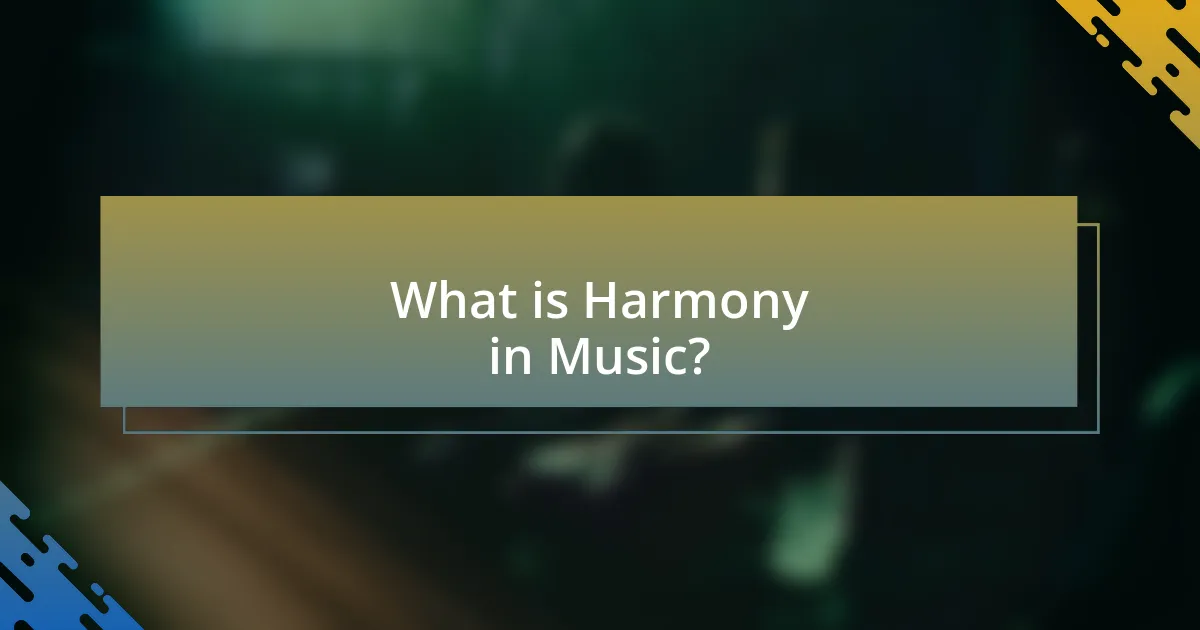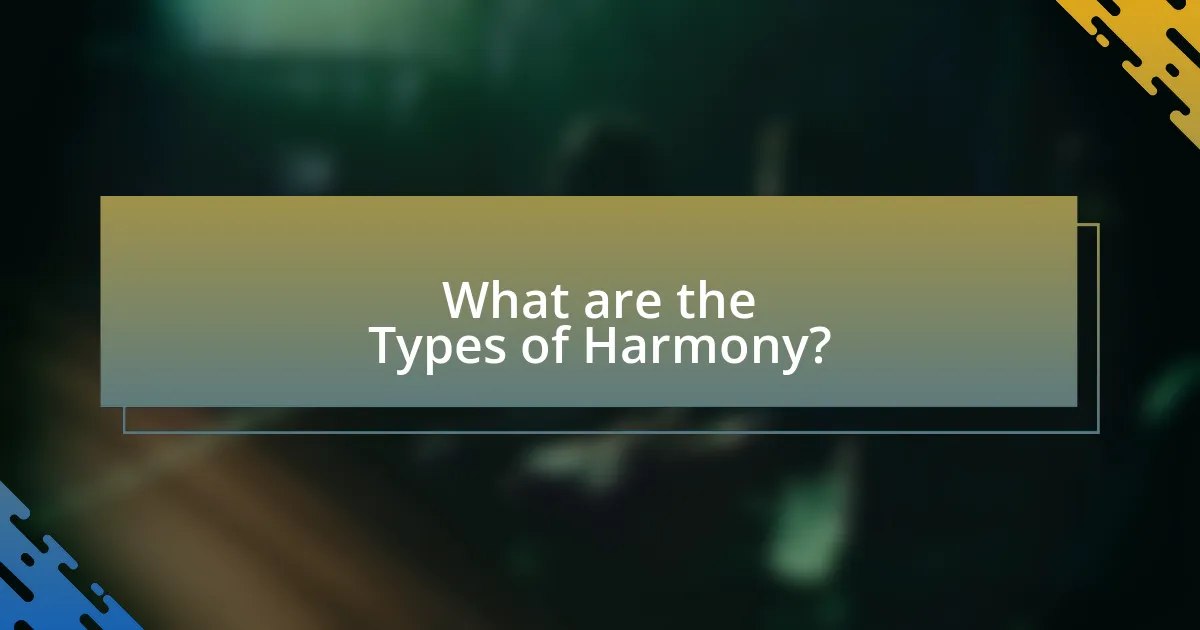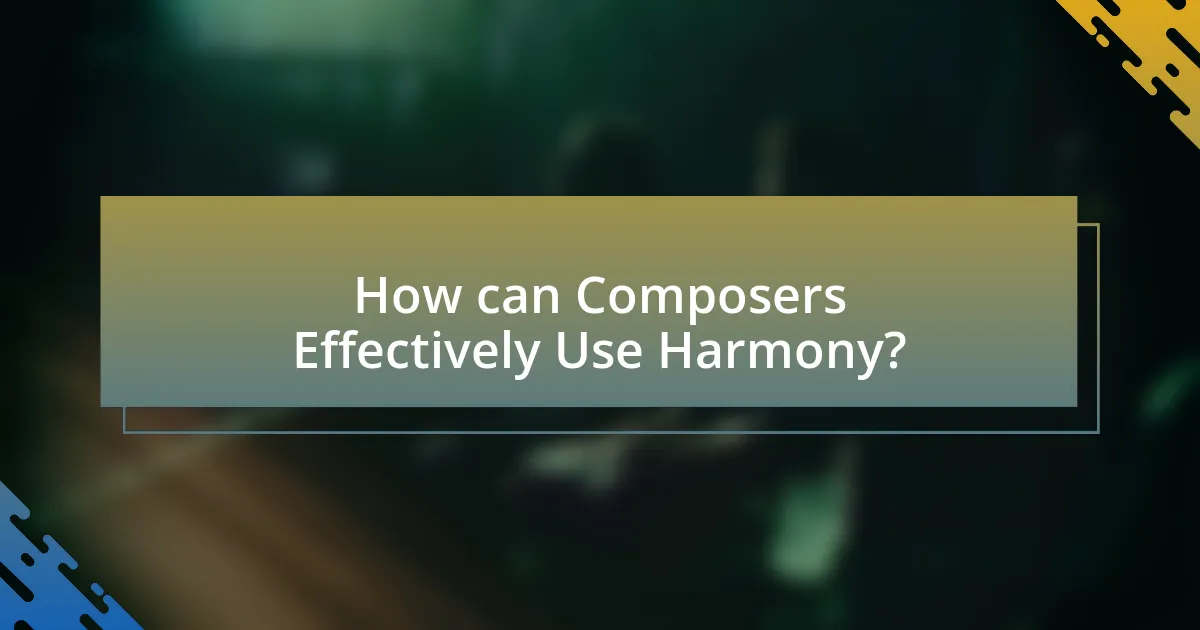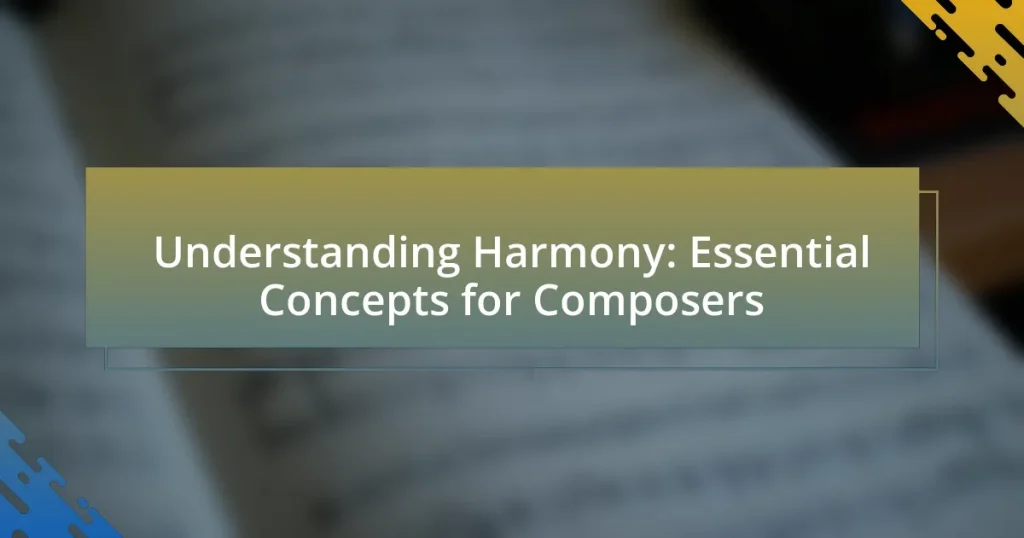Harmony in music is the simultaneous combination of different musical notes that creates a pleasing sound, essential for adding depth and emotional impact to compositions. This article explores the definition of harmony in music composition, its fundamental elements such as chords and intervals, and the distinctions between harmony, melody, and rhythm. It also examines the importance of harmony for composers, its role in emotional expression, and various types of harmony, including consonant and dissonant. Additionally, the article discusses harmonic progressions, techniques for enhancing harmonic richness, common mistakes to avoid, and practical tips for mastering harmony, providing a comprehensive understanding of how harmony shapes musical narratives and influences composition.

What is Harmony in Music?
Harmony in music refers to the combination of different musical notes played or sung simultaneously to produce a pleasing sound. This concept is fundamental in creating depth and texture in music, as it supports the melody and enhances the overall emotional impact of a piece. Harmony can be structured through chords, which are groups of notes played together, and it follows specific rules and progressions that define how these notes interact. For instance, Western music often employs triads, which consist of three notes, and utilizes harmonic progressions like the circle of fifths to create tension and resolution.
How is Harmony defined in the context of music composition?
Harmony in the context of music composition is defined as the combination of different musical notes played or sung simultaneously to produce a pleasing sound. This concept is fundamental in creating chords, which are the building blocks of harmony, and it establishes the emotional and tonal framework of a piece. Harmony can be categorized into various types, such as consonant harmony, which is stable and pleasant, and dissonant harmony, which creates tension and requires resolution. The use of harmony is essential in genres ranging from classical to contemporary music, as it enhances the overall texture and depth of compositions.
What are the fundamental elements that constitute harmony?
The fundamental elements that constitute harmony are chords, intervals, and the progression of these chords. Chords are formed by combining multiple notes played simultaneously, while intervals refer to the distance between two notes. The progression of chords creates a sense of movement and resolution in music. These elements work together to establish the tonal framework of a piece, influencing its emotional and aesthetic qualities. For instance, the use of major and minor chords can evoke different feelings, demonstrating how harmony shapes musical expression.
How does harmony differ from melody and rhythm?
Harmony differs from melody and rhythm in that it involves the combination of different musical notes played or sung simultaneously to create a chordal structure, while melody refers to a sequence of single notes that are perceived as a cohesive entity, and rhythm pertains to the timing and duration of notes in music. Harmony enriches the musical texture by providing depth and context to the melody, which is the main theme or tune, and rhythm establishes the beat and pace of the music. For example, in Western music, harmony is often built on triads, which are three-note chords, whereas melody is typically a linear progression of notes, and rhythm is defined by time signatures and note values that dictate how music is organized in time.
Why is Harmony important for composers?
Harmony is important for composers because it provides the foundational structure that supports melody and enhances emotional expression in music. By utilizing harmony, composers can create tension and resolution, guiding the listener’s emotional journey. Historical examples, such as the use of triads in Western classical music, demonstrate how harmony shapes musical narratives and influences the overall aesthetic of compositions.
What role does harmony play in creating emotional impact?
Harmony plays a crucial role in creating emotional impact by establishing the mood and atmosphere of a musical piece. It influences how listeners perceive and feel about the music, as different harmonic progressions can evoke specific emotions; for example, major chords often convey happiness, while minor chords can express sadness or tension. Research indicates that harmonic structures can trigger emotional responses in listeners, as demonstrated in studies like “The Emotional Impact of Music: A Review” by Juslin and Västfjäll, which highlights how harmony interacts with melody and rhythm to enhance emotional expression in music.
How does harmony influence the overall structure of a composition?
Harmony significantly influences the overall structure of a composition by establishing the tonal foundation and guiding the progression of musical ideas. It creates a framework within which melodies operate, shaping the emotional and aesthetic experience of the piece. For instance, harmonic progressions dictate the movement between tension and resolution, which is essential for maintaining listener engagement. The use of specific chords and their relationships can determine the form of a composition, such as verse-chorus structures in popular music or the development sections in classical sonatas. Historical examples, such as the use of functional harmony in Western classical music, illustrate how composers like Bach and Beethoven structured their works around harmonic principles, reinforcing the importance of harmony in compositional architecture.

What are the Types of Harmony?
The types of harmony include consonant harmony, dissonant harmony, and modal harmony. Consonant harmony is characterized by intervals that sound stable and pleasant, such as major and minor thirds. Dissonant harmony involves intervals that create tension and require resolution, like tritones and minor seconds. Modal harmony refers to the use of scales derived from modes, which can create unique tonalities distinct from traditional major and minor scales. These classifications help composers understand and utilize harmony effectively in their music.
What are the differences between consonant and dissonant harmony?
Consonant harmony is characterized by intervals that sound stable and pleasant, while dissonant harmony consists of intervals that create tension and a sense of instability. Consonant intervals, such as perfect fifths and major thirds, are generally perceived as harmonious and are often used to create a sense of resolution in music. In contrast, dissonant intervals, like minor seconds and tritones, evoke a feeling of unrest and are typically resolved to consonant intervals to create musical progression. This distinction is fundamental in music theory, as composers utilize consonance and dissonance to evoke emotional responses and drive musical narratives.
How do consonant harmonies create a sense of resolution?
Consonant harmonies create a sense of resolution by establishing stable and pleasing sound combinations that resolve tension in music. When consonant intervals, such as thirds and fifths, are used, they produce a feeling of completeness and rest, contrasting with dissonant harmonies that evoke tension and instability. This resolution is often achieved through the movement from dissonance to consonance, which is a fundamental principle in Western music theory, as seen in the progression from a dominant chord to a tonic chord in tonal music. The use of consonant harmonies aligns with the psychological perception of harmony, where listeners instinctively recognize and prefer these stable sound structures, reinforcing the sense of closure in musical phrases.
What effects do dissonant harmonies have on listener perception?
Dissonant harmonies create feelings of tension and unease in listener perception. This emotional response is often linked to the brain’s processing of conflicting auditory signals, which can evoke a sense of discomfort or anticipation. Research indicates that dissonance can heighten emotional engagement, as listeners may experience a stronger reaction to music that incorporates dissonant elements, leading to a more intense overall experience. For example, studies have shown that dissonant chords can activate areas of the brain associated with emotional processing, such as the amygdala, suggesting that dissonance plays a significant role in shaping how music is perceived and felt.
What are the various harmonic progressions used in composition?
Various harmonic progressions used in composition include the I-IV-V-I progression, ii-V-I progression, and the I-vi-ii-V progression. The I-IV-V-I progression is foundational in Western music, establishing a strong tonal center, while the ii-V-I progression is prevalent in jazz, creating smooth transitions between chords. The I-vi-ii-V progression, often referred to as the “circle of fifths,” is commonly used in pop music, allowing for a pleasing resolution. These progressions are essential tools for composers, providing structure and emotional depth to musical works.
How do common chord progressions shape musical narratives?
Common chord progressions shape musical narratives by establishing emotional context and guiding listener expectations. For instance, the I-IV-V-I progression is prevalent in Western music and creates a sense of resolution and familiarity, which can evoke feelings of happiness or nostalgia. Similarly, the ii-V-I progression is often used in jazz to build tension before resolving, enhancing the narrative arc of a piece. Research indicates that these progressions are rooted in cultural conventions, influencing how audiences perceive and interpret musical stories. The predictability of these patterns allows composers to manipulate emotions effectively, making them essential tools in crafting compelling musical narratives.
What are the characteristics of functional harmony?
Functional harmony is characterized by the systematic use of chords that serve specific roles within a tonal framework, primarily focusing on the relationships between tonic, dominant, and subdominant chords. This system emphasizes the resolution of dissonance to consonance, creating a sense of movement and direction in music. The dominant chord typically leads to the tonic, establishing a strong sense of resolution, while the subdominant often prepares the dominant, contributing to the overall harmonic progression. Historical context shows that functional harmony became prominent during the Common Practice Period (approximately 1600-1900), where composers like Bach and Mozart utilized these principles to create cohesive musical narratives.

How can Composers Effectively Use Harmony?
Composers can effectively use harmony by employing chord progressions that create emotional depth and tension. Utilizing established harmonic frameworks, such as the circle of fifths or diatonic harmony, allows composers to craft coherent musical narratives. For instance, the use of dominant seventh chords can create a strong resolution to tonic chords, enhancing the listener’s emotional experience. Historical examples, such as Beethoven’s symphonies, demonstrate how innovative harmonic choices can evoke specific feelings and drive the music forward.
What techniques can composers employ to enhance harmonic richness?
Composers can enhance harmonic richness by employing techniques such as extended chords, modal interchange, and counterpoint. Extended chords, which include additional notes beyond the basic triad, create more complex and colorful harmonies. For example, adding the seventh, ninth, or eleventh to a chord can significantly increase its depth. Modal interchange involves borrowing chords from parallel modes, allowing composers to introduce unexpected harmonic flavors. Counterpoint, the technique of combining independent melodic lines, enriches the harmonic texture by creating interdependent relationships between voices. These techniques are widely used in various musical genres, demonstrating their effectiveness in enhancing harmonic richness.
How can modulation be used to create interest in a piece?
Modulation can create interest in a piece by introducing new keys or tonal centers, which adds variety and emotional depth. This technique engages listeners by shifting the harmonic landscape, often enhancing the narrative or emotional arc of the music. For example, composers frequently use modulation to transition between sections, such as moving from a major key to its relative minor, which can evoke contrasting feelings and maintain listener attention. Historical examples include Beethoven’s symphonies, where key changes are strategically placed to heighten drama and sustain interest throughout the composition.
What are the benefits of using extended chords in compositions?
Extended chords enhance compositions by adding richness and complexity to harmonic structures. These chords, which include additional tones beyond the basic triad, create a more colorful and textured sound, allowing for greater emotional expression. For instance, jazz and contemporary music frequently utilize extended chords to evoke specific moods and atmospheres, demonstrating their versatility. Research indicates that the use of extended chords can lead to more engaging and dynamic musical experiences, as they provide composers with a broader palette of harmonic options to explore.
What are common mistakes to avoid when working with harmony?
Common mistakes to avoid when working with harmony include neglecting voice leading, using parallel fifths and octaves excessively, and failing to resolve dissonances properly. Neglecting voice leading can result in awkward transitions between chords, disrupting the flow of music. Excessive use of parallel fifths and octaves is often discouraged in traditional harmony because it can weaken the independence of voices. Additionally, failing to resolve dissonances creates tension that may not be effectively released, leading to an unsatisfying musical experience. These principles are foundational in harmony and are widely recognized in music theory.
How can overuse of dissonance detract from a composition?
Overuse of dissonance can detract from a composition by creating a sense of unresolved tension that may overwhelm the listener. When dissonance is excessively employed, it can lead to listener fatigue, as the constant lack of resolution can make it difficult for audiences to engage with the music emotionally. Research in music theory indicates that balance between consonance and dissonance is crucial for maintaining listener interest and emotional impact. For instance, a study published in the Journal of Music Theory by authors such as Allen Forte emphasizes that effective use of dissonance requires strategic resolution to consonance to create a satisfying musical experience.
What pitfalls should be avoided in harmonic progression choices?
Avoiding common pitfalls in harmonic progression choices is crucial for effective composition. One major pitfall is the overuse of predictable chord progressions, such as the I-IV-V-I sequence, which can lead to a lack of originality and emotional impact. Additionally, neglecting voice leading principles can result in awkward transitions between chords, disrupting the flow of the music. Another significant mistake is failing to consider the emotional context of the piece; using dissonance without resolution can create confusion rather than tension and release. Lastly, ignoring the relationship between melody and harmony can lead to a disjointed musical experience, as the harmonic choices should support and enhance the melodic line.
What practical tips can help composers master harmony?
To master harmony, composers should practice regularly with chord progressions, analyze existing works, and utilize music theory principles. Regular practice with chord progressions, such as I-IV-V-I, helps composers internalize harmonic relationships. Analyzing existing works, especially those from various genres, allows composers to understand how harmony functions in different contexts. Utilizing music theory principles, such as voice leading and counterpoint, provides a structured approach to creating harmonious compositions. These methods are supported by educational resources like “Tonal Harmony” by Stefan Kostka and Dorothy Payne, which emphasizes the importance of these techniques in developing harmonic skills.
How can studying classical harmony improve contemporary composition skills?
Studying classical harmony enhances contemporary composition skills by providing a foundational understanding of chord progressions, voice leading, and tonal relationships. This knowledge allows composers to create more sophisticated and emotionally resonant music. For instance, classical harmony emphasizes the importance of functional harmony, which helps contemporary composers develop tension and resolution in their works. Additionally, analyzing classical pieces reveals effective techniques for modulation and thematic development, which can be applied to modern genres. Historical examples, such as the works of Bach and Beethoven, demonstrate how these principles can lead to innovative compositions that resonate with audiences today.
What resources are available for composers to learn about harmony?
Composers can learn about harmony through various resources, including textbooks, online courses, and software tools. Textbooks such as “Tonal Harmony” by Stefan Kostka and Dorothy Payne provide foundational knowledge and exercises on harmonic principles. Online platforms like Coursera and Udemy offer courses specifically focused on harmony, often taught by experienced musicians and educators. Additionally, software tools like MuseScore and Sibelius allow composers to experiment with harmony in a practical setting, facilitating hands-on learning. These resources collectively support composers in mastering the essential concepts of harmony.















